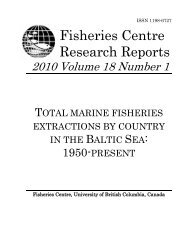Trends in GlobAl MArine Fisheries - Sea Around Us Project
Trends in GlobAl MArine Fisheries - Sea Around Us Project
Trends in GlobAl MArine Fisheries - Sea Around Us Project
You also want an ePaper? Increase the reach of your titles
YUMPU automatically turns print PDFs into web optimized ePapers that Google loves.
s–1<br />
Area = Σ [Ci + (0.5 ∙ Y )] ∙ [ln(i+1) – ln(i)]<br />
i=1<br />
i+1<br />
BA – DAP = (Area Biomass – Area Abundance )/ln s<br />
where C and Y is the cumulative and <strong>in</strong>dividual<br />
percentage of abundance or biomass of<br />
the species at abundance or biomass rank i, respectively;<br />
s is the number of reported taxonomic<br />
groups (species, genus, family or group<strong>in</strong>g).<br />
Thus, the BA-DAP <strong>in</strong>dex scales between -1 and<br />
+1, with negative values <strong>in</strong>dicat<strong>in</strong>g an abundance<br />
dom<strong>in</strong>ated system.<br />
The BA-DAP <strong>in</strong>dex was calculated for each<br />
year from 1950 to 2004 for each LME. As the<br />
<strong>in</strong>dex is normalized by the number of taxa, the<br />
<strong>in</strong>dex can be readily compared between different<br />
LMEs (or other spatial entities) and time. S<strong>in</strong>ce<br />
catch records by the number of <strong>in</strong>dividuals (C)<br />
is not available for the majority of fisheries, we<br />
obta<strong>in</strong>ed a conservative estimate of C by assum<strong>in</strong>g<br />
a power relationship between body length<br />
Figure 3. BA-DAP <strong>in</strong>dex (Biomass-Abundance-Difference <strong>in</strong> Area<br />
by Percent) based on fisheries catches (species





![Nacion.com, San José, Costa Rica [Nacionales] - Sea Around Us ...](https://img.yumpu.com/26166123/1/190x245/nacioncom-san-josac-costa-rica-nacionales-sea-around-us-.jpg?quality=85)










